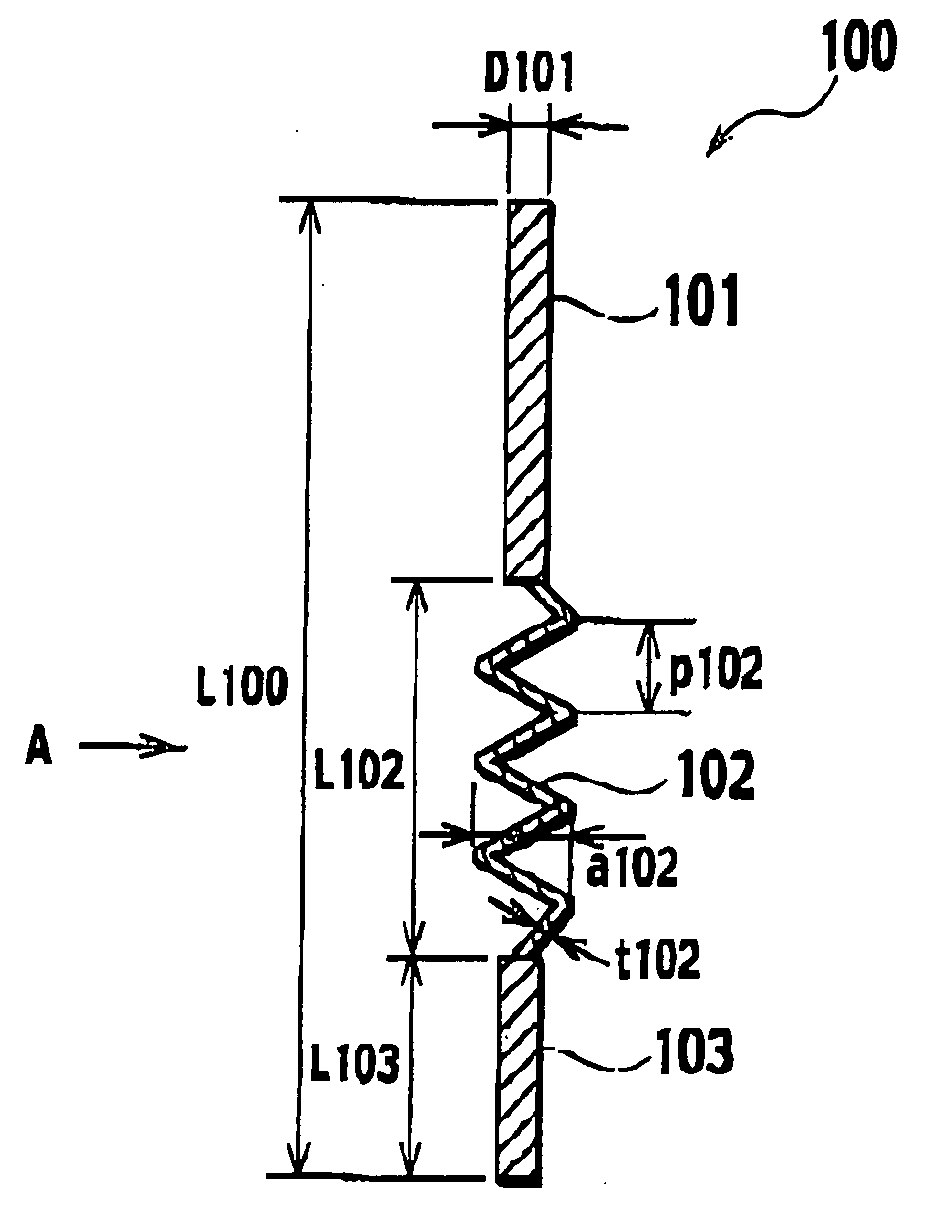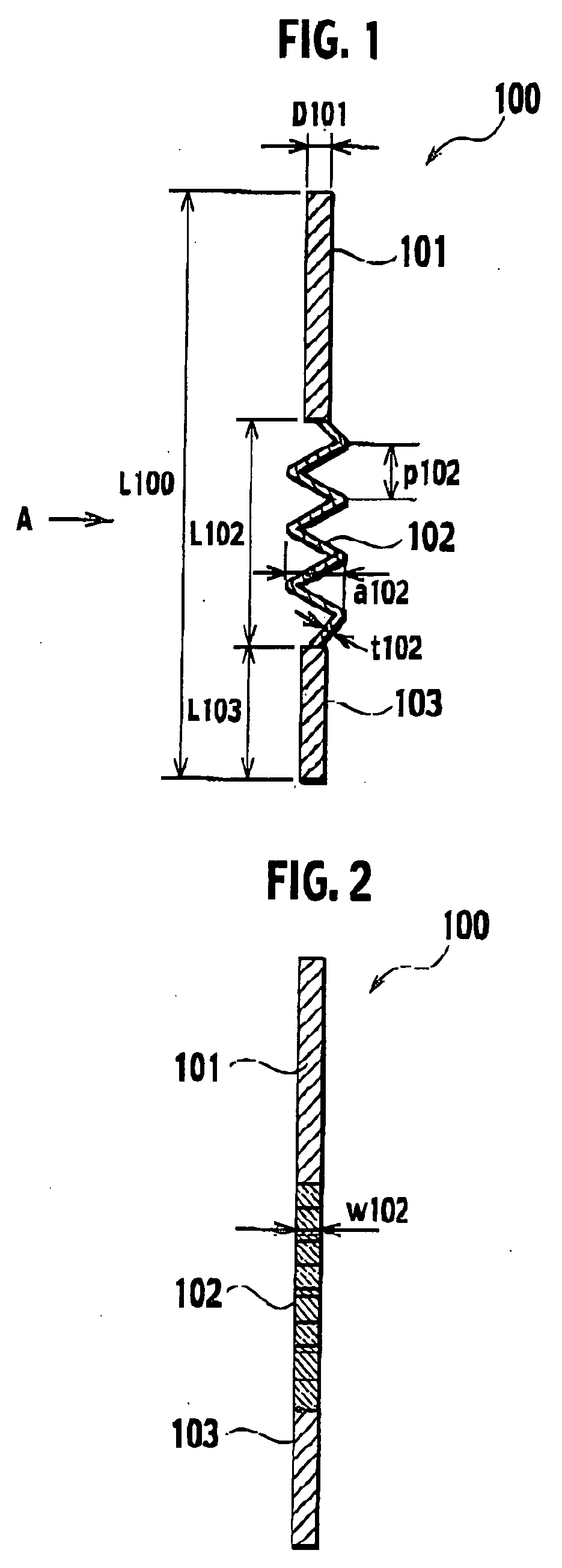Power-supplying member and heating apparatus using the same
a technology of power supply member and heating apparatus, which is applied in the direction of ohmic-resistance heating, hot plate heating arrangement, coating, etc., can solve the problems of large difference between the thermal expansion amount the tubular supporting member, excessive stress, critical cracks in the ceramic base in the vicinity of the joint part, etc., to achieve the effect of improving the reliability of the heating apparatus, facilitating buckles, and maintaining the hardness of the power supply member
- Summary
- Abstract
- Description
- Claims
- Application Information
AI Technical Summary
Benefits of technology
Problems solved by technology
Method used
Image
Examples
first embodiment
(Configuration of Power-Supplying Member)
[0028] Descriptions will be provided for a power-supplying member according to first embodiment of the present invention with reference to FIGS. 1 and 2. FIG. 1 shows a side view of the power-supplying member, and FIG. 2 shows a side view of the power-supplying member in the case the power-supplying member is viewed from direction A shown in FIG. 1.
[0029] The power-supplying member 100 according to first embodiment is disputed to a hollowed part in a tubular supporting member. A heating resistor and an electrode are embedded in a ceramic base to be supported by the supporting member. The power-supplying member 100 supplies power to at least one of the heating resistor and the electrode as power-supplied object. As shown in FIGS. 1 and 2, the power-supplying member 100 includes a first rod-shaped member 101, a second rod-shaped member 103 and a thermal-expansion absorbing member 102. The first rod-shaped member 101 is connected to the power...
second embodiment
(Configuration of Power-Supplying Member)
[0042] Hereinafter, descriptions will be provided for a power-supplying member according to a second embodiment of the present invention with reference to FIG. 4. The following descriptions will focus mainly on what makes the Second embodiment different from the first embodiment.
[0043] In the case of the second embodiment, as shown in FIG. 4, a thermal-expansion absorbing member 132 is provided with a curved portion having a amount of bend y132 which is not smaller than 0.1 [mm]. The amount of bend y132 means the distance from the centerline of a first rod-shaped member 131 and a second rod-shaped member 133 in the longitudinal direction to the thermal-expansion absorbing member 132. The thermal-expansion absorbing member 132 is not shorter than 3 [mm] in length L132 in the longitudinal direction. When necessity for maintaining a certain level of hardness of the power-supplying member 130 is taken into consideration, it in desirable that t...
third embodiment
(Configuration of Power-Supplying Member)
[0047] Hereinafter, descriptions will be provided for a power-supplying member according to a third embodiment of the present invention with reference to FIG. 5. The following descriptions will focus mainly on what makes the third embodiment different from the first embodiment.
[0048] In the case of the third embodiment, the thermal-expansion absorbing member 152 is formed from a member haying a Young's modulus which is not 50 [Gpa] or more larger than a Young's modulus of a first rod-shaped member 151 and a second rod-shaped member 153. Specific combination examples of members are described in the following examples. The length L152 of the thermal-expansion absorbing member 152 is not shorter than 0.1 [mm], but not longer than 50 [mm]. For the purpose of maintaining the hardness of the power-supplying member 150, however, it is more desirable that the length L152 should be not shorter than 0.3 [mm], but not longer than 30 [mm].
(Method of...
PUM
| Property | Measurement | Unit |
|---|---|---|
| electric current | aaaaa | aaaaa |
| electric current | aaaaa | aaaaa |
| diameter D101 | aaaaa | aaaaa |
Abstract
Description
Claims
Application Information
 Login to View More
Login to View More - R&D
- Intellectual Property
- Life Sciences
- Materials
- Tech Scout
- Unparalleled Data Quality
- Higher Quality Content
- 60% Fewer Hallucinations
Browse by: Latest US Patents, China's latest patents, Technical Efficacy Thesaurus, Application Domain, Technology Topic, Popular Technical Reports.
© 2025 PatSnap. All rights reserved.Legal|Privacy policy|Modern Slavery Act Transparency Statement|Sitemap|About US| Contact US: help@patsnap.com



